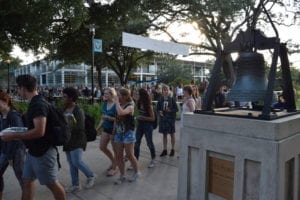Kimberlé Crenshaw is a proponent of difficult conversations. The UCLA School of Law professor and leading critical race theorist visited Tulane on Monday, September 24, bringing her message of dialogue, societal introspection, and social justice.
Walking out to a standing ovation, Crenshaw began her lecture by addressing the rise of Trumpism and what she calls “the politics of hate and resentment.” As a changemaker in the field of critical race theory, Crenshaw argues that Trump’s rule runs counterto the goals of an equitable and empathetic society.
“For all of those of us who dreamt for a society that one day willrealizeits promise of justice and real opportunity for all this last election was a rude awakening,” Crenshaw said.
She attacked thenotion that the conversation surrounding diversity led to the election of Donald Trump. Setting the stage for her hour-long lecture, Crenshaw introduced a new lens she encouraged audience members to look through to better solve and address social problems.”My hope today is to open a few pages in our social justice hymnal and pause to consider how we might play our parts differently or at least more clearly with a more decidedly focused intersectional prism,” Crenshaw said.
Crenshaw introduced and developed intersectional theory in the 1980s, a methodology of examining the overlapping components of identity and how they fit into a web of oppression. She used a frame with a picture of cows grazing in a field as an extended metaphor to explain the concept to the audienceExplaining that the cows in the image were sick, Crenshaw asked audience members to speculate as to why. She then added in more imagery to the framework, showing toxic pollution in the air.”So frames make all the difference in the world in how we frame a social problem… when we have a broader frame it helps us recognize that these cows are sick because of the toxicity in their environment, they’re sick because ofstructures and institutions that produce thetoxicitythatleads to the disease,” Crenshaw said.

Waiting in line: Students line up along McAlister Avenue, eager to see Kimberlé Crenshaw
The critical race theorist emphasized the importance of an accurate and well-informed frame in evaluating problems of oppression. This allows the changemaker to identify a problem more accurately and adjust their ideation accordingly.”Intersectionality isalsoa frame,” Crenshaw said. “It’s one that operates …tohelp us capture the reality of social power and discrimination.”With this tool in the changemaker’s toolbelt, Crenshaw encourages activists to engage with problems onan intersectional level. Before one can understand a problem and begin to ideate solutions, they must assess the situation from an intersectional lens.
Demonstrating this approach, Crenshaw challenged audience members with historical examples. Speaking about Anita Hill accusing former Supreme Court Justice Clarence Thomas of sexual harassment, the disparity between youth male and female organization endowments, and police brutality, she examined these failures in intersectional problem-solving.
Crenshaw engaged the audience in a powerful exercise to demonstrate a point about police brutality. Asking the crowd to raise their hands, Crenshaw recited a list of names: Michael Brown, Tamir Rice, Philando Castille, Eric Garner, Freddy Gray.If an audience member did not know a name they were instructed to put their hands down. Nearly every hand stayed up following the first list.
She then recited a second list: Maya Hall,KorrynGaines, MichelleCusseaux, Tanisha Anderson. Few hands remained as Crenshaw explained the lack of attention that is given to black female victims of police brutality, a failure of society to use its intersectional lens. “I do this demonstration not as anindictmentof any of us, but a way a showing of even when we want toknow, even when we’re deeply invested in this issue, the way the issue is framed,the way the media reports it, the way we organize it makes it impossible for us to really know everything we need to know,” Crenshaw said. “It’s a framing problem, all over again.”
One of Crenshaw’s many changemaking projects is the African American Policy Forum, a think tank whose purpose is “dismantling structural inequality.” In May 2015, the AAAPF launched the #sayhername campaign, in an effort to raise awareness for black female victims of police brutality. The efforts are an attempt to ease the harmful effects of a system that has failed black women.Within the field of social innovation, changemakers can utilize Crenshaw’s theory of intersectionality for a better design thinking process.
Without intersectionality, the stages of definition and ideation will be built on an uneven and skewed foundation. Maintaining a holistic view of the world around us simply makes for better changemaking. With empathy at the base ofthis work, Crenshaw’s guidance must be heeded: think critically about how behavior and action influences people at all intersections of their identities. Only then can an equitable answer be found, that encompasses all those affected by a problem with a just and multi-faceted approach.
